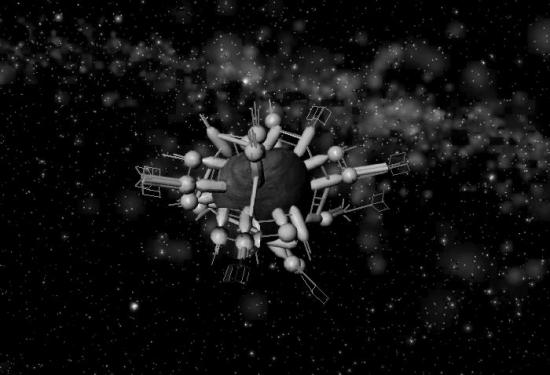BY LETTER
Frosthive
Galactography > Other Major Polities, Empires, and Meta-Empires > Hiders
Technology > Application > Infrastructure
Technology > Application > Infrastructure
 Image from Steve Bowers |
Class of Haloist habitat built to extend the useful volume of a comet or Kuiper belt body.
Frosthives are constructed by essentially turning the source body inside out. Robotic tunneling devices are first released into the object and dig their way through it by melting the ice that makes it up and pumping it to the surface. The water is then pumped outward and formed into a three-dimensional network of hundreds or thousands of tunnels and chambers in free space. Sealants, insulation, infrastructure and various habitat support systems (often biological and gengineered for conditions of low light and temperature) are then laid down inside the structure and the frosthive is complete.
Because of the ever present danger from cosmic rays, sections of the habitat which are used by individuals without high resistance to radiation damage are generally constructed with ice walls at least five metres thick. Similar protection is provided around locations using sensitive genetechnology or important databanks.
The microgravity environment allows a frosthive to grow to considerable proportions while still retaining sufficient structural strength to maintain habitable pressure in the interior (although for reasons of safety and redundancy most frosthives are limited by their inhabitants to sizes only 3-4 times larger than the dimensions of the original starting body).
Since most Haloist clades are modified to live in microgravity environments these habitats rarely include rotating sections which provide centrifugal gravity. For this reason they can look irregular and random, although some use remarkable artistic fractal-like designs. The available space inside a three-dimensional, gravity-free environment can be large compared to a similar sized habitat which has gravity, since the inhabitants are not confined to the floorspace. Rotating frosthives are often called 'snowbowls' or the equivalent in local slang.
Related Articles
- Backgrounders
- Drift
- Haloers, Haloists
- Hotpoint
- Marians, Clade Mary
- Microgravity - Text by M. Alan Kazlev
A state in which gravity is reduced to virtually negligible levels. For example, when an object is in free fall, it experiences microgravity. It is deleterious to baseline physiology, but space-adapted tweaks can survive a microgravity environment indefinitely. - Microgravity Space Habitats
Appears in Topics
Development Notes
Text by Todd Drashner
Some additions by Steve Bowers
Initially published on 05 October 2007.
Some additions by Steve Bowers
Initially published on 05 October 2007.






